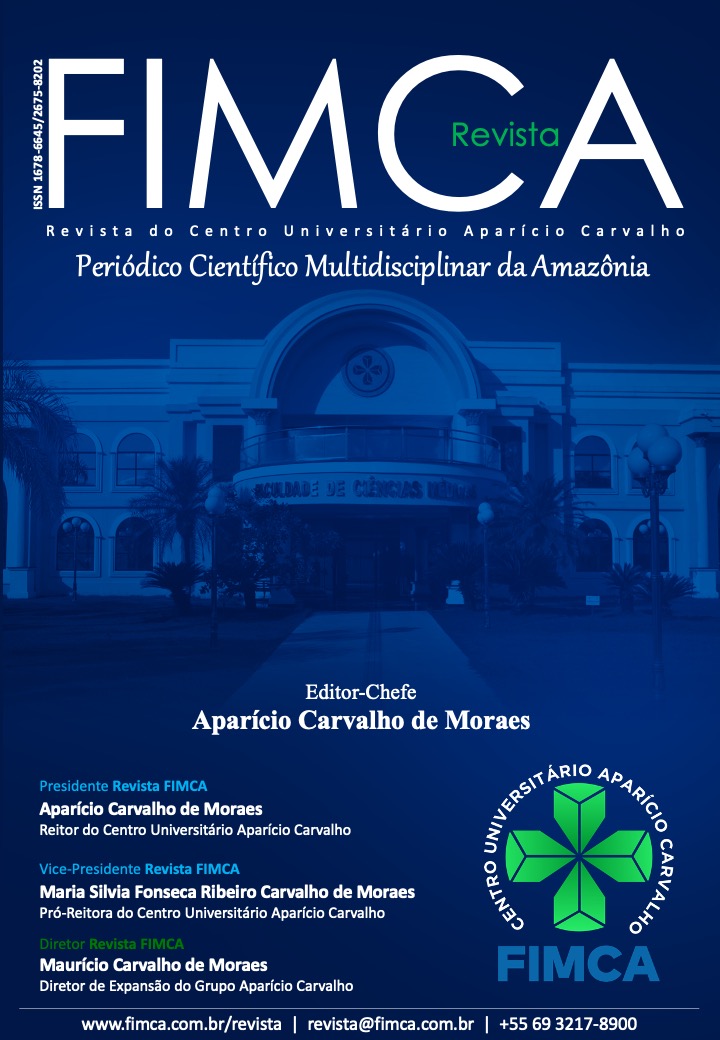FECHAMENTO DE DIASTEMA COM RECONTORNO ESTÉTICO EM RESINA COMPOSTA: UM RELATO DE CASO
DIASTEMA CLOSURE WITH AESTHETIC RECONTOUR IN COMPOSITE RESIN: A CASE REPORT
DOI:
https://doi.org/10.37157/fimca.v10i2.781Palavras-chave:
Diastema, resina composta, restauração direta e estéticaResumo
Introdução: O diastema possui acometimento multifatorial. A reabilitação com materiais restauradores revela-se com uma adequada solução para casos dessa natureza. A resina composta é uns dos materiais de escolha com propriedades estéticas satisfatórias, uma vez que promove um biomimetismo com os dentes naturais. Objetivo: Ressaltar a importância da previsibilidade do tratamento para a escolha acertada de materiais e técnicas, de forma a trazer naturalidade e devolver a harmonia do sorriso através de procedimento odontológico minimamente invasivo, capaz de alcançar resultados positivos nos aspectos funcionais, estéticos e psicológicos da paciente. Relato de caso: Paciente K.A.S, gênero feminino, 25 anos, brasileira, ASA I, cor parda, procurou a clínica de Odontologia da faculdade FIMCA/Unicentro em Jaru/RO relatando estar descontente com seu sorriso e queixando-se principalmente do espaço entre os dentes anteriores superiores. Discussão: O tratamento do diastema com a técnica de restauração direta com resina composta é baseado em um planejamento pessoal. Em alguns casos, podemos lançar mão da ortodontia para solucioná-los. Na situação ora exposta, a paciente já havia sido submetida a ortodontia sem resultado satisfatório, sendo-lhe então indicada a técnica restauradora para finalização do caso. Conclusão: Concluímos que o método apresentado alcançou os objetivos esperados. O fechamento de diastema com a utilização de resinas compostas, através da técnica direta, mostra-se vantajoso, porquanto preserva a estrutura dental, além de ser um procedimento minimamente invasivo, de baixo custo e que permite um adequado e rápido contorno.
Introduction: Diastema has multifactorial involvement. Rehabilitation with restorative materials proves to be an appropriate solution for cases of this nature. Composite resin is one of the materials of choice with satisfactory aesthetic properties, as it promotes biomimicry with natural teeth. Objective: To highlight the importance of treatment predictability for the right choice of materials and techniques, in order to bring naturalness and restore harmony to the smile through a minimally invasive dental procedure, capable of achieving positive results in the functional, aesthetic, and psychological aspects of the patient. Case report: Patient K.A.S, female, 25 years old, Brazilian, ASA I, mixed race, sought the Dentistry clinic at the FIMCA/Unicentro college in Jaru/RO reported that she was unhappy with her smile and mainly complaining about the space between the upper front teeth. Discussion: Diastema treatment with the direct restoration technique with composite resin is based on personal planning. In some cases, we can use orthodontics to solve them. In the situation presented here, the patient had already undergone orthodontics without satisfactory results and was then recommended the restorative technique to complete the case. Conclusion: We concluded that the presented method achieved the expected objectives. Diastema closure using composite resins, through the direct technique, is advantageous, as it preserves the tooth structure, in addition to being a minimally invasive, low-cost procedure that allows for adequate and rapid contouring.
Palavras-chave: Diastema, resina composta, restauração direta e estética.
ABSTRACT:
Introduction: Diastema has multifactorial involvement. Rehabilitation with restorative materials proves to be na appropriate solution for cases of this nature. Composite resin is one of the materials of choice with satisfactory aesthetic properties, as it promotes biomimicry with natural teeth. Objective: To highlight the importance of treatment predictability for the right choice of materials and techniques, in order to bring naturalness and restore harmony to the smile through a minimally invasive dental procedure, capable of achieving positive results in the functional, aesthetic and psychological aspects of the patient. Case report: Patient K.A.S, female, 25 years old, Brazilian, ASA I, mixed race, sought the Dentistry clinic at the FIMCA/Unicentro college in Jaru/Ro reportinh that she was unhappy with her smile and mainly complaining about the space between the upper front teeth. Discussion: Diastema treatment with the direct restoration technique with composite resin is based on personal planning. In some cases, we can use orthodontics to solve them. In the situation presented here, the patient had already undergone orthodontics without satisfactory results, and was then recommended the restorative technique to complete the case. Conclusion: We concluded that the presented method achieved the expected objectives. Diastema closure using composite resins, through the direct technique, is advantageous, as it preserves the tooth structure, in addition to being a minimally invasive, low-cost procedure that allows for adequate and rapid contouring.
Key Words: Diastema, composite resin, direct and aesthetic restoration.
Referências
ABDULRAHMAN MS. (2021). Evaluation of the Sealing Ability of Direct versus Direct-Indirect Veneer Techniques: Na In Vitro Study. BioMed Research International. Volume 2021, Article ID 1118728, 10 PAGES. Disponível em: file:///C:/Users/almei/Downloads/397-Texto%20do%20artigo-1787-1-10-20220801.pdf. Acesso em 20 de mar. de 2023.
ARAUJO E PERDIGÃO J. (2021). Anterior veneer restarations – Na evidence-based minimal-intervention perspective. The Journal os Adhesive Dentistry, 2021, vol.23 nº2. Disponível em: https://pubmed.ncbi.nlm.nih.gov/33825424/. Acesso em 15 de fev. de 2023.
ABAD C. C., NARANJO B., VALDIVIEZO P., Adhesive Systems Used in Indirect Restorations Cementation: Review of the Literature, Dentistry jornal, v. 2019 SN, p. 1-18, 2019. Disponível em: https://pubmed.ncbi.nlm.nih.gov/31266163/ . Acesso em 20 de mar. de 2023.
BARATIERI, LN, Monteiro JR, Andrada MAC, Vieira LCC, Ritter AV & Cardoso AC. (2001). Odontologia restauradora: fundamentos e possibilidades. São Paulo: Ed. Santos. Disponível em: http://revodonto.bvsalud.org/scielo.php?script=sci_nlinks&ref=103703&pid=S1677-3888201100010000300005&lng=pt . Acesso em 30 de mar. de 2023.
CONCEIÇÃO EN, MASOTTI A & DILLENBURG A. (2005). Análise estética. In: Conceição EM et al. Restaurações estéticas: compósitos, cerâmicas e implantes. Porto Alegre: Artmed. Disponível em: https://www.livrariaflorence.com.br/produto/livro-restauracoes-esteticas-compositos-ceramicas-e-implantes-conceicao-132025. Acesso em 10 de mar. de 2023.
CENTOLA ALB, NASCIMENTO TN & GIRALDI KCFM. (2000). Reanatomização: procedimento utilizado para reabilitação da estética – relato de caso clínico. Jornal Brasileiro de clínica Odontologica, 19(4). Disponível em: https://repositorio.usp.br/item/001546093 . Acesso em 25 de mar. de 2023.
FONSECA, R. B. et al. Técnica de Estratificação e Texturização Superficial de Resinas Compostas em Dentes Anteriores-Seis Meses de Acompanhamento. Clín. Int. j. braz. Dente, v. 9, n. 3, p. 322 – 330, 2013. Disponível em: https://pesquisa.bvsalud.org/portal/resource/pt/lil-765327. Acesso em 15 de fev. de 2023.
FAHL N Jr, RITTER AV. (2020) Composite veneers: The direct-indirect tecnique resisited. J Esthet Restor Dent, 2020, 1-13. Disponível em: https://pubmed.ncbi.nlm.nih.gov/33336852/. Acesso em 16 de mar. de 2023.
FERUSE AY, FRANCO EJ, MONDELLI J. (2008). Esthetic and functional restoration for an anterior open occlusal relationship with multiple diastemata: a multidisciplinar approach. J Prosthet Dent, 2008;99:(2)91-4. Disponível em: https://pubmed.ncbi.nlm.nih.gov/18262008/ . Acesso em 16 de mar. de 2023.
GUERRA, Micaela Lorena Raposo Seixas; VENÂNCIO, Gisely Naura; AUGUSTO, Carolina Rocha. Fechamento de diastema anteriores com resina composta direta: relato de caso. Revista da faculdade de odontologia de lins, v. 27, n. 1, p. 63-68, 2017. Disponível em: https://www.metodista.br/revistas/revistas-unimep/index.php/Fol/article/view/3029. Acesso em 6 de fev. de 2023.
HIGASHI, C. et al. Planejamento estético em dentes anteriores. In: Médicas: 2006. Disponível em: https://fampfaculdade.com.br/wp-content/uploads/2019/11/5-PLANEJAMENTO-EST%C3%89TICO-EM-DENTES-ANTERIORES-UMA-REVIS%C3%83O-DE-LITERATURA.pdf Acesso em 18 de mar. de 2023.
KOKUT B, TURKMEN C. (2020). Longevity of direct diastema closure and recontouring restorations with resin composites in maxillary anterior teeth: A 4-year clinical evaluation. J Esthet Restor Dent. 2020; 1-5. Disponivel em: https://pubmed.ncbi.nlm.nih.gov/33354867/ . Acesso em 2 de mar. de 2023.
KWON SR, OYOYO U, LI, Influence of application techniques on contact formation and voids in anterior resin composite restorations, Operative dentistry, v. 39, n. 2, p 213- 220, 2014. Disponível em: https://pubmed.ncbi.nlm.nih.gov/23875789/. Acesso em 24 de fev. 2023.
KABBACH W., SAMPAIO C. S., HIRATA R. Diastema closures: A novel technique to ensure dental proportion, Journal of esthetic and restorative dentistry: oficial publication of te American Academy of Esthetic Dentisty. v. 30, n. 4, p. 275-280, 2018. Disponível em: https://pubmed.ncbi.nlm.nih.gov/30367823/ . Acesso em 14 de fev. de 2023.
LIMA, M G. da S. et al. Reanatomização do sorriso com uso de resina composta: relato de caso. ArchivesOf Health Investigation, v. 8, n. 9, p. 501-505, 2020. Disponível em: https://www.archhealthinvestigation.com.br/ArcHI/article/view/3233. Acesso em 29 de mar. de 2023.
PONTONS MJC, et al. (2020). Bio-additive and enameloplasty technique for restoring anterior esthetics: 54-month clinical follow-up. Quintessence Int. 2020;51(8):622-629. Disponível em https://pubmed.ncbi.nlm.nih.gov/32577711/ . Acesso em 19 de fev. de 2023.
VIEIRA, P. L. S.; LIMA-ARSATI, Y. B. O. Fechamento de diastema posterior como complemento de um tratamento de um ortodôntico: caso clínico. RGO, Porto Alegre, v. 55, n. 4, p. 399-402, out./dez.2007. Disponível em: https://pesquisa.bvsalud.org/portal/resource/pt/lil-510975 . Acesso em 19 de mar. De 2023.
WHEELER B, et al. (2017). Management of the Maxillary Diastema by Various Dental Specialties. Journal of Oral and Maxillofacial Surgery. 76. 10.1016/j.joms.2017.11.024. Disponível em: https://www.researchgate.net/publication/321263171_Management_of_the_Maxillary_Diastema_by_Various_Dental_Specialties. Acesso em 14 de mar. de 2023.
YANKELSON, M. (1973). Altering canines to resemble lateral incisors missing. A new techinique. J. Int. Dent. Child, 4:30-40. Disponível em: https://pubmed.ncbi.nlm.nih.gov/4620645/ . Acesso em 2 de mar. de 2023.
Publicado
Como Citar
Edição
Seção
A Revista FIMCA disponibiliza seus artigos e resumos para livre acesso de forma permanente e gratuita nos termos da Creative Commons Attribution License, permitindo que a sociedade possa compartilhar (copiar e redistribuir o material em qualquer suporte ou formato para qualquer fim, mesmo que comercial) e adaptar (remixar, transformar, e criar a partir do material para qualquer fim, mesmo que comercial), desde que seja dado o devido crédito apropriado, provendo um link para a licença e indicar se mudanças foram feitas.
Vale a pena ressaltar, que mesmo que o material seja transformado, modificado, ou der origem a outro material, este deve ser distribuido respeitando obrigatoriamente a citação do original nos termos da licença CC BY-AS 4.0 DEED.

















